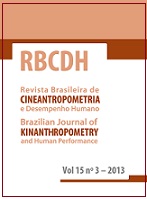Estratégia adotada em provas de natação estilo crawl: uma análise das distâncias de 800 e 1500m.
DOI:
https://doi.org/10.1590/1980-0037.2013v15n3p361Resumo
Em competições de natação de longadistância não está bem estabelecida qual a estratégia de prova (EP) ótima. Desta forma, o objetivo desse estudo foi caracterizar as EP adotadas poratletas de nível internacional em provas de natação de 800m (feminino) e 1500m (masculino) crawl. Foram analisadas as parciais de tempo (a cada 50m) dos atletas (n = 60) participantes das semifinais e finais dos últimos três campeonatos mundiais de natação, ocorridos no período de 2006 a 2010. A análise dos dados foi realizada por meio do teste estatístico CHAID (Chi-Squared Automatic Interaction Detection), que é uma estatística ?2 (qui-quadrado) para detectar comportamento de homogeneidade entre as variáveis. Os principais resultados encontrados foram: para as duas provas analisadas, o comportamento davelocidade em função do tempo mostrou-se semelhante à estratégia parabólica(formato em U), caracterizada por um início significativamente mais rápido (P <0,05), seguido por uma diminuição do ritmo no trecho médio da prova, quando ocorre um novo aumento significativo (P < 0,05) na velocidade no trecho final. Desta forma, tais achados indicam que este perfil de EP pode ser classificado como ótimo para as provas de natação consideradas de longa duração, visto que foi o perfil preferencialmente adotado por atletas de nível mundial.
Downloads
Publicado
Edição
Seção
Licença

Direitos Autorais para artigos publicados nesta revista são do autor, com direitos de primeira publicação para a revista. Em virtude da aparecerem nesta revista de acesso público, os artigos são de uso gratuito, com atribuições próprias, em aplicações educacionais e não-comerciais, desde que seja dada a atribuição. Esta obra foi licenciada com uma Licença Creative Commons Atribuição 4.0 Internacional - CC BY


